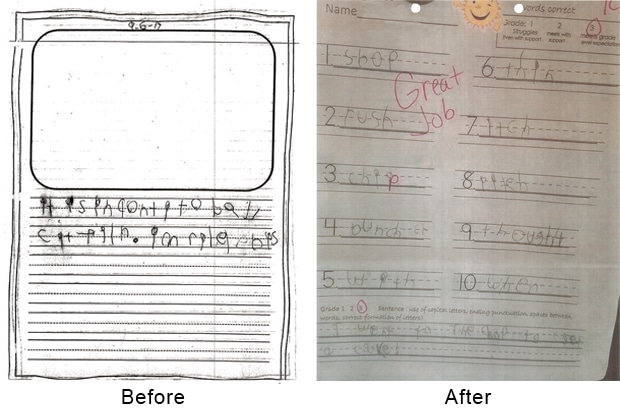Most parents want the best for their children; they are proud of their academic and athletic accomplishments and yearn for their children to find success and happiness. A diagnosis of ADD or ADHD can be devastating, particularly when the only options presented for helping control the symptoms include medication. Additionally, parents may see a different child at home in a one-on-one environment than the teacher sees at school. Children who have attention deficits are often frustrated with school, and begin to doubt their own abilities.
But what if the same symptoms that are indicators of ADD and ADHD are actually caused by something else? What is these attention deficit issues could be treated naturally instead of requiring powerful stimulants? This is the story of one child whose mother knew he could do better in the classroom with help outside of the the typicaly resources used to address ADD and ADHD.
Meet Harrison
Harrison is a very bright kid. At eight years old, he’s taller and runs faster than any other kid in his class. He has excellent coordination and is already an amazing athlete. Just like many kids his age, he’s immensely curious about the world around him, and he is always trying to figure things out. Give him a math problem, and it is done fast, in his head — and it’s correct. He won’t show the work because he knows the answer — writing down the steps just slows him down. However, Harrison was having an exceedingly difficult time with his spelling; he didn’t much like reading, and his handwriting was illegible scrawl.
Even with help at home and from a tutor, Harrison didn’t see any improvement. He had a hard time comprehending instructions from the teacher, and she often had to repeat herself. And, as if that wasn’t enough, he was having bedwetting problems, which was impacting his social relationships and causing self-esteem issues.
Harrison’s teachers wanted to put him on ADHD medications based on the symptoms they were seeing in class, but his mother refused. She understood the ramifications of having a child labeled as ADHD and was wary of the side effects of ADHD medications.
Harrison’s mother heard Dr. Schurger speak about his own problems with allergies, chronic sinusitis, and back pain, but took special note when he mentioned that he had also suffered as a child from bedwetting. These conditions tend to put a damper on childhood social interactions, including sleepovers and dating. Dr. Schurger shared that once he was under chiropractic care, he no longer suffered many of these secondary conditions plaguing him. Harrison’s mother quickly connected the dots for her son — it was time to set up an evaluation for Harrison.

The root of the problem
At Harrison’s first appointment, Dr. Schurger performed an extensive neurological and radiological evaluation and quickly found that the first bone in Harrison’s neck had shifted out of place, causing a neurostructural “body imbalance” and pressure on Harrison’s brainstem. After reviewing the results with Harrison and his mom, Dr. Schurger performed a quick adjustment. While he had had chiropractic treatments before, he wouldn’t let other chiropractors work on his neck. He quickly felt comfortable enough with Dr. Schurger to let him adjust his neck, a gentle procedure that involved no twisting or popping.
The next day, Harrison was at home reading a book, and he asked his mom, “Why aren’t the letters blurry anymore?” Due to the neurostructural shift, Harrison’s eyes hadn’t been tracking together properly, causing him to have slightly blurred vision. Once that misalignment was corrected, things began to come together once that misalignment was corrected.
Focus was just the tip of the iceberg of Harrison’s improvements. Within a week, he was able to get 8 out of 10 on his spelling test (up from 2 or 3 out of 10 before!), and soon after was getting 10 out of 10 every week. His handwriting greatly improved, the bedwetting issues dried up, and he quickly developed a love of reading! These dramatic outcomes were all without any medications.
Harrison’s mom attributes all of the changes purely to the specific type of chiropractic care that Dr. Schurger provided. Harrison’s life is better now that he doesn’t have to deal with these conditions restricting his potential. And Harrison’s teacher has seen such a vast improvement that she can’t believe she had ever recommended him for behavioral therapy or ADHD medications, since she no longer saw any of the symptoms.
Chiropractic for children
Harrison is not the exception to the rule. Many children suffer needlessly from conditions and symptoms brought on a neurostructural shift. Because a child’s nervous system develops rapidly in the first five years of life, children need specific chiropractic care just as much — if not more — than adults. Difficulties during childbirth, falls when learning to walk, and other childhood mishaps all can cause these neurostructural shifts in their upper cervical spine that may present as “normal” childhood issues.
Additionally, until they almost complete puberty, children perceive aches and pains differently than adults. A child’s the pain pathways don’t respond the same, often presenting as ticklish sensations instead of pain. Nervous system interference throughout this period of development may lead to altered pain perception as an adult. Straightening things out during puberty is imperative, so the pathways don’t become fixed in an altered pattern.
The other popular presentation of neurostructural shifts is the need for an “attitude” adjustment. Out-of-the-ordinary behavior is a sign that a child may need a trip to see Dr. Schurger. Regardless the age, a seemingly small shift can introduce difficulties into a child’s life, and sometimes all it takes is a gentle repositioning to get them back on track.
Dr. Schurger’s practice, Upper Cervical Springfield, is located at 450 S. Durkin Drive, Suite B in Springfield. Call 217-698-7900 or email drschurger@mac.com to arrange a consultation. Visit www.uppercervicalspringfield.com for more information and to begin your journey back to better health.

Recent Comments